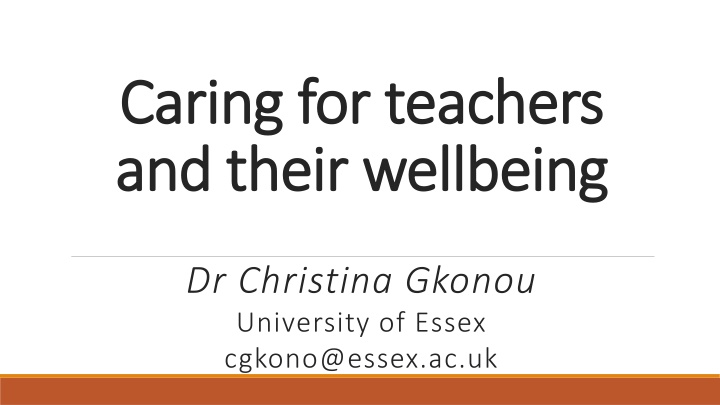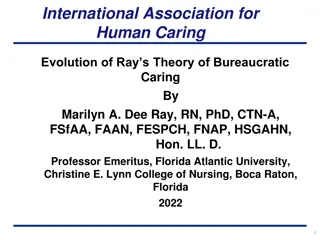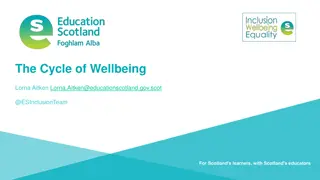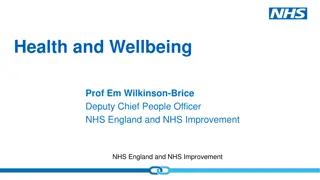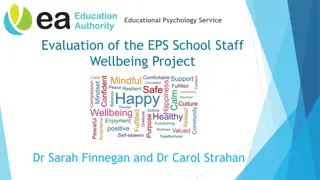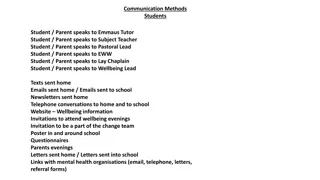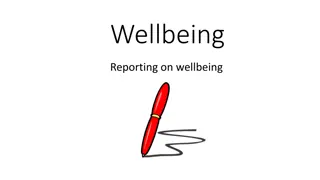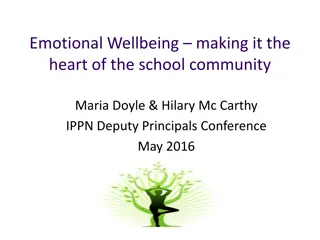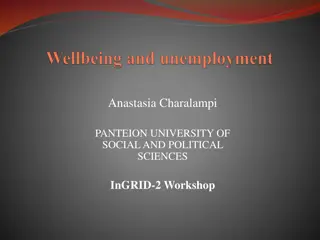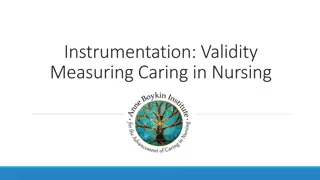Caring for teachers and their wellbeing
Teachers' wellbeing is essential for a positive work environment. This content explores the challenges faced by educators, the importance of focusing on wellbeing, and strategies to enhance emotional, physical, and spiritual health. Additionally, it addresses the impact of stress, anxiety, and performance-based assessments on teachers' longevity in the profession.
Download Presentation

Please find below an Image/Link to download the presentation.
The content on the website is provided AS IS for your information and personal use only. It may not be sold, licensed, or shared on other websites without obtaining consent from the author.If you encounter any issues during the download, it is possible that the publisher has removed the file from their server.
You are allowed to download the files provided on this website for personal or commercial use, subject to the condition that they are used lawfully. All files are the property of their respective owners.
The content on the website is provided AS IS for your information and personal use only. It may not be sold, licensed, or shared on other websites without obtaining consent from the author.
E N D
Presentation Transcript
Caring for teachers Caring for teachers and their wellbeing and their wellbeing Dr Christina Gkonou University of Essex cgkono@essex.ac.uk
Content Content Defining wellbeing Why focus on wellbeing? Wellbeing among (language) teachers Cultivating wellbeing 2
Wellbeing challenge! Wellbeing challenge! What is the one thing that you might want to do differently with respect to your wellbeing? 3
Defining wellbeing Defining wellbeing 4
No precise definition No precise definition Wellbeing: we are feeling good and functioning well Associated with stress but not the opposite of stress Does not simply refer to how individuals can be relaxed, comfortable and happy all the time (Holmes, 2005, 2019) 5
Four core aspects Four core aspects Spiritual wellbeing Physical wellbeing Intellectual wellbeing Emotional wellbeing 6
Why focus on wellbeing? Why focus on wellbeing? 7
Why focus on wellbeing? Why focus on wellbeing? Performance-based assessment of teachers can result in high stress levels loss of sleep, anxiety, irritability/mood swings. Teacher retention and professional longevity US/UK: 1/3 of teachers leave the profession within 5 years of training. 8
Why focus on wellbeing? Why focus on wellbeing? Anxiety causes an over-focus on threatening stimuli, e.g. failure and mistakes. Anxiety reduces motivation and the ability to concentrate. Both can result in poor performance for students. 9
Wellbeing among Wellbeing among (language) teachers (language) teachers 10
Teachers Teachers Lead busy lives (Day & Gu, 2010) personal and professional commitments Are the central hub in the classroom Influence students learning and psychologies emotional contagion (Frenzel & Stephens, 2013; Williams, Mercer, & Ryan, 2015) 11
In the workplace In the workplace excessive workload/demands interpersonal relationships (with colleagues, students, parents) lack of support, own autonomy and control issues with one s professional role (e.g. responsibilities, adjustment to change, career prospects, personal fulfilment) disengaged students 12
Whos affected? (1) Who s affected? (1) All teachers likely to be affected Some are immune to stressors; others are more vulnerable (Hiver, 2017; Hiver & D rnyei, 2015) 13
Whos affected? (2) Who s affected? (2) Newly qualified teachers: high rates of attrition (Guarino, Santiba ez, & Daley, 2006; UNESCO Institute for Statistics, 2016) Mid-career teachers: longer term, chronic stress and burnout (Kyriacou, 2001; Maslach, Schaufeli, & Leiter, 2001) Leaders/managers: own and others wellbeing (Bristow, Ireson, & Coleman, 2007; Leithwood, Steinbach, & Jantzi, 2002) 14
Language teachers (1) Language teachers (1) Native vs. non-native (Medgyes, 1997) inherent ideological assumptions about superiority of one group over the other accent? learning vs. acquisition? empathy? 15
Language teachers (2) Language teachers (2) Language teacher anxiety, other emotions, concern over professional identities (Gkonou, Dewaele, & King, 2020) Limiting self-beliefs Impact on teaching practice and expectations of their professional role 16
Language teachers (3) Language teachers (3) Large classes Online classes Communication is hindered Implications for classroom management and teacher roles 17
Within language education Within language education Wellbeing only recently discussed (Brierton & Gkonou, in preparation; MacIntyre et al., 2019; Mercer & Gregersen, 2020) Emotions (focus on anxiety) Emotional intelligence Burnout 18
How to cultivate How to cultivate wellbeing wellbeing 19
Teacher education Teacher education Socio-emotional dimensions of teaching Technical skills/teaching methods 20
A selfish approach to teaching? A selfish approach to teaching? [from Christina s research] So in other words, the question here, I find completely against what I am about. So this is question 9: Describe what you do on a regular basis during your teaching of English to make sure that you feel a positive emotion . I do not go into a class focusing on myself. It s not about me. It s about the students. So I m focused entirely on the students. I don t mind about myself, I m not there for me. I m not there to feel good or not feel bad. So this question is a nonsense to me. Your question is nonsense. 21
Not at all selfish Not at all selfish Looking after ourselves before we are able to look after others. 22
Strategies (1) Strategies (1) Increasing teacher self-awareness the self-critic Being reflective Being personally and professionally effective and efficient (e.g. time management skills) Journaling and/or action research projects 23
Possible exercise Possible exercise Think of a time when you felt capable of and in control of your stress, at work or in your life overall. What is different now? Draft a plan outlining what you would like to improve. For each area of improvement, describe your current state, your target and some practical steps that can help you reach that target. 24
Work and life Work and life (Adapted from Eyre, 2016) (Adapted from Eyre, 2016) a. b. work work life work life c. work- life d. life work 25
Strategies (2) Strategies (2) Encouraging teachers to ask for help Encouraging peer dialogue Encouraging caring and healthy relationships with colleagues co-teaching, peer reviews of teaching, sharing of good practice 26
Possible exercise Possible exercise Make a list of the people that you could turn to for help, if needed. In addition, reflect specifically on how each person on the list could help you. 27
Strategies (3) Strategies (3) Building and maintaining a strong and supportive relationship with students (Gkonou & Mercer, 2017; Mercer & Kostoulas, 2018) Classroom management Encouraging teachers to be effective communicators verbal (e.g. humour) and nonverbal (e.g. eye contact, gestures) communication (Gregersen & MacIntyre, 2017) 28
Possible exercise Possible exercise Think of/Ask colleagues/Search for techniques that are used in class to help you relate with your students, communicate effectively with them etc. Indicate how often you make use of each of these techniques. For those techniques that you do not (often) use, reflect on why this is so and how/when you could use them in class. 29
Conclusion Conclusion Teacher wellbeing as key priority in contemporary classrooms (there is hope!) Improving wellbeing requires whole school cultural change. Students matter but teachers matter too. Student wellbeing begins with teacher wellbeing! 30
Wellbeing challenge! Wellbeing challenge! What change will you make the next time you re in the classroom? (Or before or after class?) 31
Thank you 32
